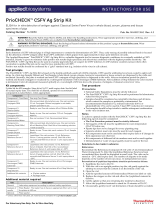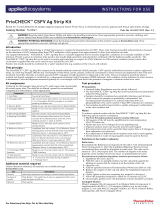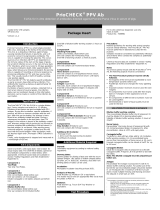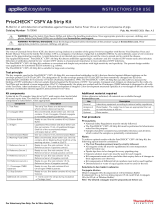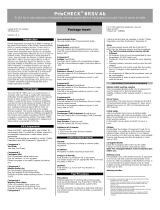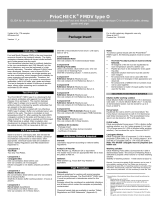Page is loading ...

PrioCHECK® CSFV Ag
ELISA for in vitro detection of antigen against Classical Swine Fever Virus in whole blood, serum, plasma and tissue
specimens of pigs
5 plate kit for 450 samples
©Prionics AG
Version 1.0_e
For in-vitro veterinary diagnostic use only
Store at 5±3°C
Product No.: 7610050
Introduction
Early detection of CSFV infected pigs is of high impor-
tance to contain the dissemination of CSFV. Thus,
early tracing of possibly infected herds is focused on
the detection of CSFV antigen rather than CSFV
antibodies which appear from approximately 14 days
post-infection onwards.
The PrioCHECK® CSFV Ag is a valuable diagnostic
tool to increase diagnostic confidence to eventually
establish a CSFV infection. Priority is given to mini-
mize false positive test results (high specificity and
selectivity) combined with the highest possible sensi-
tivity. The PrioCHECK® CSFV Ag can be used to
examine pig herds that are suspect for CSFV infection.
In CSF endemic countries (areas) where often vacci-
nation is applied the test can be used to trace residual
foci of CSFV.
Positive test results should be confirmed by a "gold"
standard test (e.g. isolation of the virus in cell culture).
Test Principle
The PrioCHECK® CSFV Ag is based on the double-
antibody-sandwich (DAS) principle. CSFV-specific
antibodies have been coated to eight-well strips. In a
first step Sample Diluent and Test Sample (whole
blood, serum, plasma, leucocyte concentrate or tissue
extract) are dispensed to the wells and incubated.
Secondly, the plate is washed and anti-CSFV conju-
gate of high specificity is dispensed to the wells. After
an incubation period the plate is washed and bound
conjugate is visualized by a subsequent incubation
with Chromogen (TMB) Substrate. After addition of
Stop Solution the color reaction is terminated. Color
development measured optically at a wavelength of
450 nm shows the presence of antigens of classical
swine fever virus.
Kit Components
Store kit at 5±3°C until expiry date. See kit label for
actual expiry date. The shelf life of diluted, opened or
reconstituted components is noted below, when
appropriate. Chemical hazard data are available in
section “Safety Regulations and R&S Statements”
(Appendix II).
Component 1
Test Plate
Five strip Test Plates.
Component 2
Conjugate (30x)
(30x concentrated, dilute before use). One vial con-
tains 2.2 ml Conjugate.
Diluted conjugate is not stable, prepare just before
use.
Component 3
Dilution Buffer (Ready-to-use)
One vial contains 60 ml Dilution Buffer.
Component 4
Conjugate Additive (Ready-to-use)
One vial contains 12.0 ml Conjugate Additive.
Component 5
Demineralized Water
One vial contains 10 ml Demineralized Water.
Component 6
Washing Fluid (200x)
(200x concentrated, dilute before use). One vial
contains 60 ml Washing Fluid.
Shelf life of the washing solution: 1 week at 22±3°C.
Component 7
Sample Diluent (Ready-to-use)
Three vials, each contains 10 ml Sample Diluent.
Component 8
Reference Serum 1 (lyophilized)
One vial contains 1.5 ml Reference Serum 1 (strong
positive control).
Shelf life of the reconstituted Reference Serum 1: until
expiry date at -20°C.
Component 9
Reference Serum 2 (lyophilized)
One vial contains 1.5 ml Reference Serum 2 (blank).
Shelf life of the reconstituted Reference Serum 2: until
expiry date at -20°C.
Component 10
Reference Serum 3 (lyophilized)
One vial contains 1.5 ml Reference Serum 3 (weak
positive control).
Shelf life of the reconstituted Reference Serum 3: until
expiry date at -20°C.
Component 11
Chromogen (TMB) Substrate (Ready-to-use)
One vial contains 60 ml Chromogen (TMB) Substrate.
Component 12
Stop Solution (Ready-to-use)
One vial contains 60 ml Stop Solution.
Additional Kit Contents:
- 10 plate sealers
- Package Insert
- Certificate of Analysis
Additional Material Required
General:
Laboratory equipment according to national safety
regulations.
Analysis of Results:
Plate Reader e.g. Multiscan EX or equivalent.
The reader has to have an appropriate filter set to read
the plates at 450 nm.
Optional:
Plate washer e.g. Tecan EIA Tray Washer or
equivalent.
Test Procedure
Precautions
National guidelines for working with animal samples
must be strictly followed. The PrioCHECK® CSFV Ag
must be performed in laboratories suited for this
purpose.
Samples should be considered as potentially infectious
and all items which contact the samples as potentially
contaminated. For decontamination Halamid (1%),
sodium hydroxide (0.4%) or glutaraldehyde (1%) can
be used (4-5 log CSFV reduction in 6 minutes).
Test samples should be kept sterile to enable subse-
quent confirmation in the virus isolation test.
Chemical hazard data are available in section “Safety
Regulations and R&S Statements” (Appendix II).
Notes
To achieve optimal results with the PrioCHECK®
CSFV Ag, the following aspects must be considered:
The Test Procedure protocol must be strictly
followed.
All reagents of the kit must be equilibrated to
room temperature (22±3°C) before use.
Pipette tips have to be changed for every pipet-
ting step.
Separate solution reservoirs must be used for
each reagent.
Kit components must not be used after their
expiry date or if changes in their appearance are
observed.
Kit components of different kit lot numbers must
not be used together.
Demineralized or water of equal quality must be
used for the test.
SOLUTIONS TO BE MADE IN ADVANCE
References
Reconstitute1 the References (Component 8 – 10) with
1.5 ml Demineralized Water (Component 5). After the
lyophilized Reference Sera have been reconstituted
they should be aliquotted in small vials. The vials can
be stored at -20°C until expiry date. The number of
aliquots to be made depends on the number of test
runs (max. 12 independent test runs).
Conjugate dilution
Dilute Conjugate (30x) (Component 2) in Dilution
Buffer (Component 3) supplemented with 20% (v/v)
Conjugate Additive; e.g. for one plate prepare 12 ml
(add 2,4 ml Conjugate Additive to 9,2 ml Dilution
Buffer, subsequently, add 400 µl Conjugate (30x)).
Washing solution
The Washing Fluid (Component 6) must be diluted
1/200 in demineralized water and is sufficient for a
final volume of 12 liters washing solution.
Stability of washing solution: 1 week stored at 22±3°C.
Remark: The washing of the wells after incubation is critical. A
blank optical density (OD of reference 2) of >0.300 most likely
can be ascribed to inadequate washing of the wells. Manual
washing of the wells must be performed at least 6 times:
dispense 300 µl washing solution to each well, empty the wells
carefully by tapping the Test Plate and refill. Omit formation of
air bubbles when filling the wells. Take care that after the last
washing any residual washing solution is removed by tapping
the Test Plate on tissue paper. When using automatic washers
and blank OD values >0.300 are obtained, wash manually as
described above.
Note: see Appendix IV for sample preparation
procedure and storage
INCUBATION OF SERUM AND TEST SAMPLE
1.1 Label each strip on the Test Plate (Component
1) with a marker pen.
1.2 Dispense 50 µl Sample Diluent (Component 7)
to all wells.
1.3 Dispense 50 µl of reconstituted reference serum
1 to well A1 and B1.
1.4 Dispense 50 µl of reconstituted reference serum
2 to well C1 and D1.
1.5 Dispense 50 µl of reconstituted reference serum
3 to well E1 and F1.
1.6 Dispense 50 µl of test sample to the remaining
wells.
1.7 Seal the Test Plate with a plate sealer and shake
the Test Plate gently.
1Reconstitution of lyophilized ingredients should be performed as follows:
- Equilibrate the vial to 22±3°C.
- With the vial in an upright position, tap the vial gently against the
tabletop to ensure that the content is on the bottom of the vial.
- Open the vial.
- Add the specified amount of Demineralized Water (see label on vial).
- Replace the stopper on the vial and allow the lyophilized material to
dissolve.
- Gently agitate so that any remaining dry material is dissolved.
- Allow the lyophilized material to stand for 15 minutes at 22±3°C.
- Occasionally, gently invert vial (formation of foam should be avoided).
Package Insert

PrioCHECK
®
CSFV Ag
1.8 Incubate 180±5 minutes at 22±3°C.
Note: When dispensing whole blood samples take
care that no residual sample remains in pipette tip.
INCUBATION WITH CONJUGATE
2.1 Wash the Test Plate 6 times with 300 µl washing
solution per well. Tap the plate firmly after the
last wash cycle.
Note: No residual blood should be left in the wells.
2.2 Dispense 100 µl of the diluted conjugate to all
wells.
2.3 Seal the Test Plate with a plate sealer.
2.4 Incubate 60±5 minutes at 22±3°C.
INCUBATION WITH CHROMOGEN (TMB) SUB-
STRATE
3.1 Wash the Test Plate 6 times with 300 µl washing
solution per well. Tap the plate firmly after the
last wash cycle.
3.2 Dispense 100 µl Chromogen (TMB) Substrate
(Component 11) to all wells.
3.3 Incubate 15 minutes at 22±3°C. Do not shake.
3.4 Add 100 µl Stop Solution (Component 12).
3.5 Mix the contents of the wells of the plate.
Note: Start the addition of Stop Solution 15 minutes
after the first well was filled with Chromogen (TMB)
Substrate. Add the Stop Solution in the same order
and the same place as the Chromogen (TMB) Sub-
strate was dispensed.
READING OF THE TEST AND CALCULATING THE
RESULTS
4.1 Measure the optical density (OD) of the wells at
450 nm within 15 minutes after color develop-
ment has been stopped.
4.2 Calculate the mean OD450 of wells C1 and D1
(Reference 2 = OD450 blank).
4.3 Calculate the corrected OD450 of Reference 1
and all samples by subtracting the OD450 blank.
4.4 The percentage positivity (PP) of Reference 3
and of the test samples are calculated according
to the formula below.
The corrected OD450 values of all samples are ex-
pressed as percentage positivity (PP) relative to the
corrected mean OD450 value of reference 1.
corrected OD450 test sample
PP = -------------------------------------------- x 100
corrected OD450 Reference 1
RESULT INTERPRETATION
Validation criteria
5.1 The OD450 of Reference 2 must be <0.350.
5.2 The corrected OD450 of Reference 1 must be at
least 0.750.
5.3 The PP of Reference 3 must be >20%.
Note: Not meeting any of these criteria is reason to
discard the results of that specific test run.
Note: If the corrected mean OD450 of Reference 1 is
below 0.750 possibly the Chromogen (TMB) Substrate
is too cold. In that case warm the solution to 22±3°C or
incubate up to 30 minutes. If the corrected mean
OD450 of Reference 1 is above 2.000 a shorter incuba-
tion period with the Chromogen (TMB) Substrate is
recommended.
Interpretation of the percent positivity
PP = <15% (negative)
No detectable antigen present in the test sample.
PP = ≥15% (positive)
CSFV antigen is present in the test sample.
The presence of CSFV in antigen-positive samples
should be confirmed by virus isolation.
Appendix I
Notice
This manual is believed to be complete and accurate at the time
of publication. In no event shall Prionics AG be liable for
incidental or consequential damage in connection with or
arising from the use of this manual.
Liability
Prionics AG warrants its products will meet their applicable
published specification when used in accordance with their
applicable instructions and within the declared products life
time. Prionics AG makes no other warranty, expressed or
implied. There is no warranty of merchantability or fitness for a
particular purpose. The warranty provided herein and the data,
specifications and descriptions of Prionics AG products appear-
ing in Prionics AG published catalogues and product literature
may not be altered except by express written agreement signed
by an officer of Prionics AG. Representation, oral or written,
which are inconsistent with this warranty or such publications
are not authorized and if given, should not be relied upon.
In the event of a breach of the foregoing warranty, Prionics
AG’s sole obligation shall be to repair or replace, at its option,
the applicable product or part thereof, provided the customer
notifies Prionics AG promptly of any such breach. If after
exercising reasonable efforts, Prionics AG is unable to repair or
replace the product or part, then Prionics AG shall refund to the
customer all monies paid for such applicable product or part.
Prionics AG shall not be liable for consequential, incidental,
special or any other indirect damages resulting from economic
loss or property damage sustained by any customer from the
use of its products.
Prionics AG and Prionics Lelystad BV are ISO 9001:2000
certified companies.
Appendix II
Safety Regulations and R&S Statements
National Safety Regulations must be strictly followed.
Component 1
Test Plate
Hazard Code: This product is not classified according to EU
regulations.
Component 2
Conjugate (30x)
Hazard Code: This product is not classified according to EU
regulations.
Component 3
Dilution Buffer (Ready-to-use)
Hazard Code: This product is not classified according to EU
regulations.
Component 4
Conjugate Additive (Ready-to-use)
Hazard Code: This product is not classified according to EU
regulations.
Component 5
Demineralized Water
Hazard Code: These products are not classified according to
EU regulations.
Component 6
Washing Fluid (200x)
Hazard Code: This product is not classified according to EU
regulations.
Component 7
Sample Diluent (Ready-to-use)
Hazard Code: This product is not classified according to EU
regulations.
Component 8
Reference Serum 1 (lyophilized)
Hazard Code: This product is not classified according to EU
regulations.
Component 9
Reference Serum 2 (lyophilized)
Hazard Code: This product is not classified according to EU
regulations.
Component 10
Reference Serum 3 (lyophilized)
Hazard Code: This product is not classified according to EU
regulations.
Component 11
Chromogen (TMB) Substrate (Ready-to-use)
Hazard Code: This product is not classified according to EU
regulations.
Component 12
Stop Solution (Ready-to-use)
Hazard Code: R35: Causes severe burns.
S26: In case of contact with eyes, rinse immediately with plenty
of water and seek medical advice.
S36/37/39: Wear suitable protective clothing, gloves and
eye/face protection.
S45: In case of accident or if feel unwell, seek medical advice
immediately (show label on vial).
Appendix III
References
1) Ressang, A.A., (1973). Zbl. Vet. Med. B 20, 256 – 271.
2) Wensvoort et al, (1986). Vet. Microbiol. 12, 101 – 108.
3) Kaden et al, (1999). Berl. Münch. Tierärtzl. Wschr., 112, 52 -
57.
4) Martin et al, (1992). Prev. Vet. Med. 14, 33 – 34.
Appendix IV
Sample preparation procedure and storage
Several procedures can be followed to prepare a
tissue extract for subsequent testing in the Pri-
oCHECK® CSFV Ag and virus isolation in cell culture.
The procedure described below is adopted from the
method routinely used at the Reference Laboratory for
CSF of the Institute for Animal Health and Science in
the Netherlands.
Blood and plasma samples
Anticoagulant whole blood samples (preferably hepa-
rin blood) or plasma should preferably not be frozen
but stored at 5±3°C (max. 7 days) before testing.
Serum
Serum samples can be tested directly or after storage
at -70°C. After testing, the serum samples can be
stored at -70°C (to preserve viable virus).
Preparation of tissue extract
Cut 1-2 grams of the tissue in small pieces and
grind these into a homogenous paste using a mor-
tar and pestle and a small amount of medium. Use
sterile sand as an abrasive when necessary.
Per gram tissue add 9 ml Earle’s MEM (supple-
mented with 5 times the normal concentration of
antibiotics streptomycin, penicillin and mycostatin).
Incubate 1 hour at 22±3°C.
Centrifuge the suspension for 20±1 minutes at
6000x g.
Carefully collect the supernatant and discard the
sediment.
Aliquot the suspension in at least 2 vials.
Store the vials at -70°C.
Preparation of leukocyte concentrate
Prior to testing, the collected leucocyte fractions of a
blood sample is preferably frozen (-20ºC) and thawed.
Dispense 8 ml 0.83% NH4Cl solution in a 15 ml
tube.
Add 4 ml anticoagulated whole blood sample.
Mix the content of the tube and incubate 30 minutes
at 22±3°C in order to obtain complete lysis of the
red blood cells.
Centrifuge for 10 minutes at 500x g at 22±3°C.
Discard the supernatant.
Re-suspend the leucocyte pellet in 400 µl Earle’s
MEM (supplemented with 5% foetal calf serum and
antibiotics streptomycin, penicillin and mycostatin).
Store at -70°C (to preserve viable virus).
Contact
Prionics Lelystad B.V.
Platinastraat 33
P.O. Box 2271
NL-8203 AG Lelystad
The Netherlands
Tel. +31 320 714000
Fax +31 320 714029
Prionics AG
Wagistrasse 27a
CH-8952 Schlieren-Zurich
Switzerland
Tel. +41 44 200 2000
Fax +41 44 200 2010
www.prionics.com
For our distribution network, please refer to www.prionics.com
/

